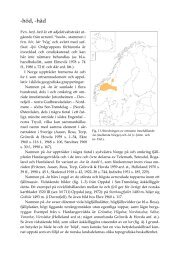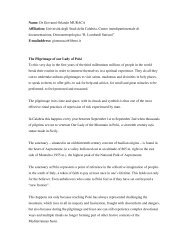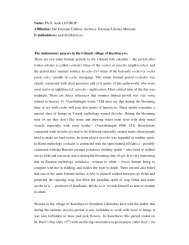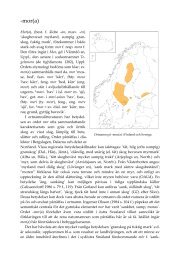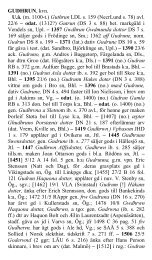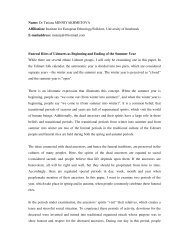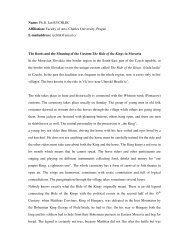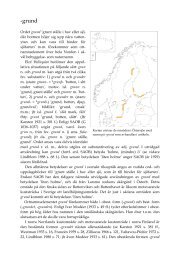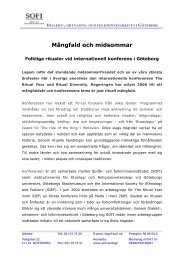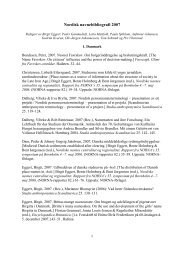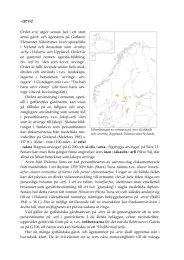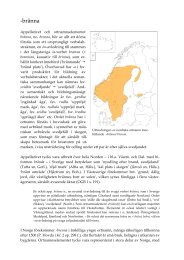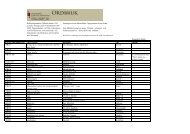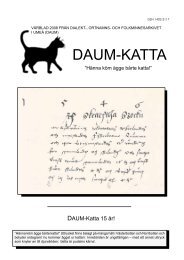NORNA-RAPPORTER 88 Binamn. Uppkomst, bildning, terminologi ...
NORNA-RAPPORTER 88 Binamn. Uppkomst, bildning, terminologi ...
NORNA-RAPPORTER 88 Binamn. Uppkomst, bildning, terminologi ...
You also want an ePaper? Increase the reach of your titles
YUMPU automatically turns print PDFs into web optimized ePapers that Google loves.
126 Johnny Grandjean Gøgsig Jakobsen<br />
SRD = Scriptores rerum Danicarum medii ævi. Udg. J. Langebek & P. F. Suhm. 1772–<br />
1878. København.<br />
Sundqvist, Birger, 1957: Deutsche und niederländische Personenbeinamen in Schweden<br />
bis 1420. Beinamen nach Herkunft und Wohnstätte. Stockholm. (AS 3.)<br />
Thomsen, Marianne, 1942: Aarhus Hospital i det tidligere Sortebrødrekloster. Århus.<br />
VSD = Vitae sanctorum Danorum. Udg. M.C. Gertz. 1908–12. København.<br />
Weeke, C., 1<strong>88</strong>4–89: Lunde Domkapitels Gavebøger. Libri datici Lundenses. København.<br />
Summary<br />
Johannes, dictus Kalf, hujus loci decanus<br />
Ecclesiastical bynames in mediaeval Scandinavia<br />
By Johnny Grandjean Gøgsig Jakobsen<br />
Bynames were used quite frequently among the high clergy of Scandinavia over the<br />
period c. 1200–1536. In two samples, from a convent of Dominican friars in Tallinn in<br />
1246 and the cathedral chapter of canons secular in Roskilde in 1460, 42 per cent and<br />
14 per cent, respectively, had bynames. This seems to cover quite well the overall range<br />
of byname frequency within cathedral chapters and Dominican convents. Ecclesiastical<br />
bynames enjoyed such acceptance that they were commonly used in various official<br />
documents. For the present survey, 242 bynames were collected, referring either to<br />
canons secular of the cathedral chapters of Lund and Roskilde, or to Dominican friars<br />
from all of Scandinavia. The names can be divided into two main groups: family bynames<br />
(14–42 per cent) and individual bynames (45–77 per cent); the individual names<br />
are further divided into two subgroups of bynames referring to places (29–36 per cent)<br />
and personally descriptive bynames (17–42 per cent). The range of percentages for each<br />
group reflects the fact that several of the names cannot be assigned with certainty to just<br />
one of the groups, but could for instance just as well be a family byname as a personally<br />
descriptive byname. The minimum values thus represent the bynames classified with<br />
certainty, while the maximum values also include all the uncertain bynames that may<br />
belong to the group in question.<br />
The article presents a good number of examples from each byname group, along with<br />
an attempt to interpret the etymology of each name, including how and why they came<br />
into use. The study suggests that family bynames were more common among the canons<br />
secular, whereas individual bynames referring to places had a higher frequency among<br />
the friars. As regards changes over time, the study indicates a shift from greater use of<br />
personally descriptive bynames in the 13th and 14th centuries towards more family bynames<br />
(among the canons) and more bynames referring to places (among the friars) in<br />
the 15th and 16th centuries. Although the personally descriptive bynames often seem to<br />
have had somewhat joking and even pejorative meanings, they were still used in official<br />
contexts, and apparently with both the knowledge and the acceptance of the person concerned.<br />
To the author, this suggests that there was much more humour and self-irony<br />
among the higher clergy of medieval Scandinavia than has traditionally been discerned<br />
from the sources.



